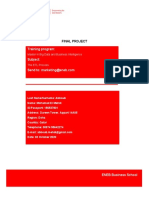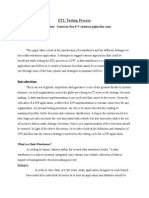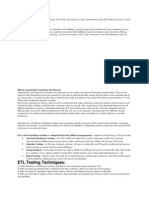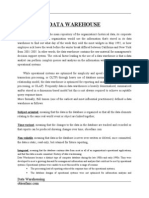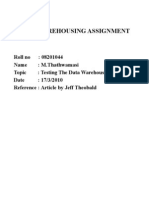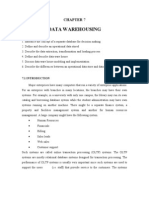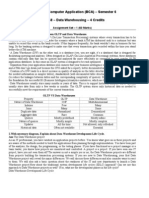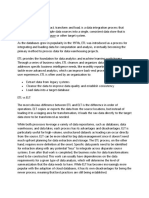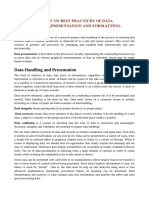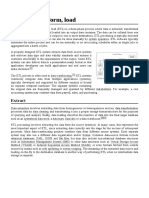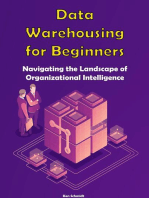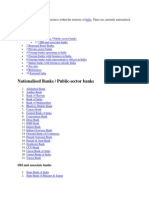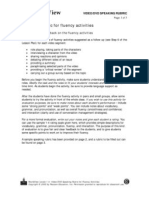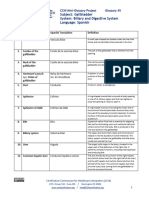Data Warehousing ETL Checklist
Data Warehousing ETL Checklist
Uploaded by
pdoconnoCopyright:
Available Formats
Data Warehousing ETL Checklist
Data Warehousing ETL Checklist
Uploaded by
pdoconnoOriginal Description:
Copyright
Available Formats
Share this document
Did you find this document useful?
Is this content inappropriate?
Copyright:
Available Formats
Data Warehousing ETL Checklist
Data Warehousing ETL Checklist
Uploaded by
pdoconnoCopyright:
Available Formats
Data Warehousing ETL Checklist
INTRODUCTION
ETL Extract, Transform and Load is the process by which data from multiple
systems is consolidated, typically in a data warehouse, so that executives can obtain a
comprehensive picture of business functions, e.g. the relationships between marketing
campaigns, sales, production and distribution. It has been estimated that in any data
integration proect, ETL will consume !" to #" percent of the time and resources.
The process is complicated and has been the subect of numerous books. $nyone
undertaking an ETL proect for the first time will have to do some serious research. %ere
is a high&level checklist of the important topics.
CHECKLIST
' ()*+E. The conventional wisdom is, ,-on.t try to boil the ocean./ It.s more
important to deliver business results than it is to have a comprehensive program.
In some cases, it may be better for the business as a whole to leave certain data
sources untouched.
' T$01ET (2(TE3 )*4TE4T. The content of the target system will drive the
whole proect, and will of course be determined by business needs. (pecifically,
target system content will determine which source systems will be involved.
' -$T$ (*50)E( 6(*50)E (2(TE3(7. The first step in the process is
identifying the systems from which the data will be extracted. There are two
broad categories8
Internal data. This is data from within your organi9ation. :rom a technical point
of view, sources can range from E0+, )03 and legacy applications to flat files
and even Excel spreadsheets. It.s important to become very familiar with the
data in all internal sources as part of the planning process.
External -ata. *ften, when a database 6e.g. a data warehouse7 is to be used for
decision support, its usefulness can be greatly enhanced when the internal data
is supplemented with external data such as demographic information on
customers.
' *;4E0(%I+. It.s critical to determine who will take responsibility for the data
in its new ,home,/ and who will be responsible for maintaining the update
process 6which includes taking responsibility for the data.s accuracy7.
' 3*-E *: E<E)5TI*4. There are three options for executing the ETL process8
%ome grown. ;riting code in&house used to be the most common approach to
ETL. This approach is often the easiest for small proects, and has the advantage
of being able to handle the idiosyncrasies of unusual data formats. *n the
negative side, home grown code re=uires maintenance over time, and often has
scalability problems.
>rd +arty bolt&on. ?olt&on modules for existing systems are often a convenient
approach, however they often mandate data formats that are not very flexible
and can cause trouble when it comes to accommodating data from other sources.
+ackaged systems. (ystems from pure&play data integration companies offer
flexibility and relative ease&of&use, but may be costly and re=uire more training
than the other two solutions.
' -$T$ +0*:ILI41. This process provides metrics on the =uality of the data in
source systems prior to beginning the proect and can help predict the difficulties
that will be involved in data re&use.
' -$T$ T0$4(:*03$TI*4
)leansing. (ource system data typically must be cleansed. The most important
aspect of cleansing is usually ,de&duping/ the removal of multiple files
identifying the same item or person, e.g. @. (mith and @ohn (mith, both with the
same address. )leansing also involves removal 6or correction7 of files with
incorrect data, e.g. an address in the name field, and establishing default values.
0eformatting. The data must be standardi9ed in terms of nomenclature and
format.
Enhancement. -ata associated with marketing is often enhanced via external
sources, which creates a re=uirement for additional fields beyond those
associated with the internal data.
$ggregationA)alculation. If there are to be aggregated or calculated fields, it.s
necessary to determine at what point in the process the aggregationAcalculation
will take place. This is an issue during the initial population of the new database
and in its ongoing maintenance.
' 4*3E4)L$T50E. 4aming conventions can have a disproportionate effect on
user satisfaction, and users should by all means be involved in decisions involving
names.
:ield names. *ne issue is what to name the new fields, e.g. ,(ex/ vs. ,1ender/
vs. ,3r.A3rs.A3s./ ;henever possible, the field names in the target system
should match 6or be derived from7 the field names in the source systems. It is
easier for all involved if the data model column names also match the target
system field names.
-ata names. The same issue exists with data names. The paint called ,0ed >#/
by the E0+ may be called ,%ot )rimson/ in the marketing database.
' 3ET$-$T$. There are two types of metadata to be considered.
Technical metadata is concerned with data types, lengths, source mappings and
other details that are relevant to developers.
?usiness metadata is information that would be potentially useful to end users,
such as valid values, mandatory vs. optional indications, and source systems.
' (E)50IT2. (ecurity is extremely important with sensitive data, e.g. customer
records that include personal data like date of birth or financial information such
as credit card numbers.
' TI3I41. *nce the initial data has been loaded into the target system, it.s
necessary to determine how often it will be refreshed. This depends primarily on
business needs. -o managers need to track a number 6sales, inventory, hours, etc.7
on a =uarterly, monthly, weekly or daily basisB *ther considerations involve the
=uantity of data to be transferred and the speed of the process.
' T0$I4I41. If you choose a >rd party bolt&on or a packaged system, the
developers involved will most likely need training. They may also need training in
a database reporting tool and if it.s new the scheduling system.
You might also like
- THE ETL PROCESS - Abboub - Mohamed - El - MehdiDocument14 pagesTHE ETL PROCESS - Abboub - Mohamed - El - MehdiMehdi Abboub100% (1)
- THE STEP BY STEP GUIDE FOR SUCCESSFUL IMPLEMENTATION OF DATA LAKE-LAKEHOUSE-DATA WAREHOUSE: "THE STEP BY STEP GUIDE FOR SUCCESSFUL IMPLEMENTATION OF DATA LAKE-LAKEHOUSE-DATA WAREHOUSE"From EverandTHE STEP BY STEP GUIDE FOR SUCCESSFUL IMPLEMENTATION OF DATA LAKE-LAKEHOUSE-DATA WAREHOUSE: "THE STEP BY STEP GUIDE FOR SUCCESSFUL IMPLEMENTATION OF DATA LAKE-LAKEHOUSE-DATA WAREHOUSE"Rating: 2 out of 5 stars2/5 (2)
- ETL TestingDocument12 pagesETL Testinggullipalli100% (1)
- 9-1-1969 Project Red HorseDocument128 pages9-1-1969 Project Red HorseRobert ValeNo ratings yet
- DWH Concepts OverviewDocument11 pagesDWH Concepts Overviewramu546No ratings yet
- Data Integration Best PracticesDocument17 pagesData Integration Best PracticesSNo ratings yet
- DWH and Testing1Document11 pagesDWH and Testing1ramu546No ratings yet
- Information Process Technology - HSC Study NotesDocument5 pagesInformation Process Technology - HSC Study NotesJack FilibaNo ratings yet
- ETL SpecificDocument12 pagesETL Specificshamjishrihari1498No ratings yet
- Data Integration and The Extraction, Transformation and Loading ProcessesDocument5 pagesData Integration and The Extraction, Transformation and Loading ProcessesPoet CruzNo ratings yet
- Data Modeling: Agnivesh KumarDocument21 pagesData Modeling: Agnivesh KumarAgnivesh Kumar100% (1)
- ETL ConceptsDocument56 pagesETL ConceptsAtanu Chatterjee100% (3)
- Experiment No. 04: Real-Life ETL CycleDocument4 pagesExperiment No. 04: Real-Life ETL Cyclesayali nazareNo ratings yet
- ETL TestingDocument12 pagesETL TestingNeeharika Uppalapati100% (2)
- ETL (Extract, Transform, and Load) ProcessDocument8 pagesETL (Extract, Transform, and Load) ProcessYOGESH ICAD-QANo ratings yet
- The Process of Updating The Data WarehouseDocument24 pagesThe Process of Updating The Data WarehousepatnaikminiNo ratings yet
- ETL (Extract, Transform, and Load) Process in Data WarehouseDocument6 pagesETL (Extract, Transform, and Load) Process in Data WarehouseDivya guptaNo ratings yet
- ETL TestingDocument5 pagesETL TestingaavijitdasNo ratings yet
- Data Warehousing EC-1 Regular Feb 2011 SolutionsDocument5 pagesData Warehousing EC-1 Regular Feb 2011 SolutionsShivam ShuklaNo ratings yet
- Data WarehouseDocument69 pagesData WarehouseHemanta Kumar DashNo ratings yet
- Etlpresentation 150731190020 Lva1 App6891Document36 pagesEtlpresentation 150731190020 Lva1 App6891lovingbabiluNo ratings yet
- Computer Fundamentals (Final)Document23 pagesComputer Fundamentals (Final)SiddharthNo ratings yet
- Pavan Kumar ResumeDocument7 pagesPavan Kumar Resumepavan212121No ratings yet
- Chapter 1Document13 pagesChapter 1JayaJayashNo ratings yet
- Test MaterialDocument6 pagesTest MaterialAyushi SharmaNo ratings yet
- Name: RAVI Mobile: +91-9591371947 ObjectiveDocument3 pagesName: RAVI Mobile: +91-9591371947 ObjectivePrathyush KanchiReddyNo ratings yet
- What Is ETL?: ETL Is A Process That Extracts The Data From Different Source Systems, ThenDocument7 pagesWhat Is ETL?: ETL Is A Process That Extracts The Data From Different Source Systems, ThenQwertyNo ratings yet
- Data WarehousingDocument16 pagesData WarehousingRaman SinghNo ratings yet
- Characteristics of Data WarehousingDocument5 pagesCharacteristics of Data WarehousingAnamika Rai PandeyNo ratings yet
- DW AsigDocument5 pagesDW AsigThathwamasi LathaNo ratings yet
- ELT ProcessDocument80 pagesELT ProcessalhamzahaudaiNo ratings yet
- Unit IVDocument28 pagesUnit IV476No ratings yet
- ETLQA/Tester Datawarehouse QA/Tester Should HaveDocument12 pagesETLQA/Tester Datawarehouse QA/Tester Should Haveganesh_reddyeceNo ratings yet
- Extract, Transform, LoadDocument8 pagesExtract, Transform, Loadnadjem menaceurNo ratings yet
- Warehouse CompleteDocument6 pagesWarehouse CompletegurugabruNo ratings yet
- Business Intelligence: Multi-Dimensional Analysis ToolsDocument35 pagesBusiness Intelligence: Multi-Dimensional Analysis ToolsSuman SharmaNo ratings yet
- Data Warehouse ArchitectureDocument8 pagesData Warehouse Architecturerishabh28072002No ratings yet
- The Design of The Information Hub: Denise RogersDocument4 pagesThe Design of The Information Hub: Denise RogersBalachandraKSNo ratings yet
- (ETL) Ahmad Abdalkareem LaftaDocument8 pages(ETL) Ahmad Abdalkareem LaftaSarmad Salih Jawad AlkodaryNo ratings yet
- ETL TestingDocument12 pagesETL Testingsempoline12345678No ratings yet
- ETLDocument3 pagesETLsurajNo ratings yet
- Sheila A. Ibia Bsit 2 What Is ETL (Extract, Transform, Load) ?Document5 pagesSheila A. Ibia Bsit 2 What Is ETL (Extract, Transform, Load) ?Sheila IbiaNo ratings yet
- ETL ProcessDocument11 pagesETL ProcessRasheeduddin sayyadNo ratings yet
- ETL Process: (Extract, Transform, and Load) ProcessDocument21 pagesETL Process: (Extract, Transform, and Load) ProcessShankar AggarwalNo ratings yet
- What Is ETL?Document6 pagesWhat Is ETL?final yearNo ratings yet
- ETL Testing GoalsDocument3 pagesETL Testing GoalssinhrajNo ratings yet
- By MR Remo Etl QuestionsDocument15 pagesBy MR Remo Etl QuestionsNarayana Reddy SannapureddyNo ratings yet
- Report On Best Practices of Data Handling, Presentation and FormattingDocument5 pagesReport On Best Practices of Data Handling, Presentation and FormattingAtimango jacklineNo ratings yet
- Big Data and Data ScienceDocument6 pagesBig Data and Data ScienceAishwarya JagtapNo ratings yet
- Extract, Transform, LoadDocument9 pagesExtract, Transform, Loadjohn949No ratings yet
- Machine Learning 2Document37 pagesMachine Learning 2suvajit2021No ratings yet
- DATA WAREHOUSES AND DATA MINING Unit 7 - 1Document9 pagesDATA WAREHOUSES AND DATA MINING Unit 7 - 1Aditya KaushalNo ratings yet
- DMBI Unit-1Document37 pagesDMBI Unit-1Paras SharmaNo ratings yet
- Data and DW Lab Manual UpdatedDocument44 pagesData and DW Lab Manual UpdatedVineet AggarwalNo ratings yet
- Data Engineering - Beginner's GuideDocument9 pagesData Engineering - Beginner's GuideSRINIVAS RAO100% (1)
- Data Warehousing: Optimizing Data Storage And Retrieval For Business SuccessFrom EverandData Warehousing: Optimizing Data Storage And Retrieval For Business SuccessNo ratings yet
- Zero To Mastery In Cybersecurity- Become Zero To Hero In Cybersecurity, This Cybersecurity Book Covers A-Z Cybersecurity Concepts, 2022 Latest EditionFrom EverandZero To Mastery In Cybersecurity- Become Zero To Hero In Cybersecurity, This Cybersecurity Book Covers A-Z Cybersecurity Concepts, 2022 Latest EditionNo ratings yet
- Advanced Analytics with Transact-SQL: Exploring Hidden Patterns and Rules in Your DataFrom EverandAdvanced Analytics with Transact-SQL: Exploring Hidden Patterns and Rules in Your DataNo ratings yet
- EM7054T-I: Product Information PacketDocument11 pagesEM7054T-I: Product Information PacketCikalong YardNo ratings yet
- Mat1l Chap12 PDFDocument74 pagesMat1l Chap12 PDFiammikemillsNo ratings yet
- Republic Act No. 9418-Volunteer Act of 2007Document9 pagesRepublic Act No. 9418-Volunteer Act of 2007energyvortexNo ratings yet
- 304 Stainless Steel Technical Data SheetDocument4 pages304 Stainless Steel Technical Data SheetMani KannaNo ratings yet
- Unit 4 - LearningDocument4 pagesUnit 4 - LearningMuhammet SuleimanNo ratings yet
- Articulo Luis Diaz 2014Document8 pagesArticulo Luis Diaz 2014Andres CoboNo ratings yet
- Chennai To Rjy Train TicketDocument1 pageChennai To Rjy Train TicketvetsasNo ratings yet
- ZXZDocument6 pagesZXZVishal VishNo ratings yet
- UNIT 1 Listening and Speaking SkillsDocument2 pagesUNIT 1 Listening and Speaking SkillsMinh Hoa NgoNo ratings yet
- Sas #25 - Accounting Information SystemDocument5 pagesSas #25 - Accounting Information SystemEuli Mae SomeraNo ratings yet
- Paramount Maths Volume - 2 in Hindi PDFDocument277 pagesParamount Maths Volume - 2 in Hindi PDFbirladevendra2001No ratings yet
- WvvideospeakingrubricDocument3 pagesWvvideospeakingrubricReddishtree ʚϊɞNo ratings yet
- Statistical Quality ControlDocument14 pagesStatistical Quality Controldimas.arya.ignatiusNo ratings yet
- 4060 Demobilization Plan SampleDocument4 pages4060 Demobilization Plan SampleDoug YoungNo ratings yet
- Hospital Scorecard - DepartmentwiseDocument4 pagesHospital Scorecard - DepartmentwiseNatasha BhasinNo ratings yet
- Petty Cash VoucherDocument4 pagesPetty Cash VoucherUgen SparkNo ratings yet
- Civil War WebQuestDocument5 pagesCivil War WebQuestShyam PatelNo ratings yet
- Chapter 12 Capital Marketing ResearchDocument11 pagesChapter 12 Capital Marketing ResearchThomas HWNo ratings yet
- CTCDocument30 pagesCTCNilesh MandlikNo ratings yet
- 15 Apil 2021: Stsenth A 7eks The of OnDocument4 pages15 Apil 2021: Stsenth A 7eks The of OnMarisha BhattiNo ratings yet
- Quanta Atomic SheetDocument55 pagesQuanta Atomic SheetVenkatarao KankanalaNo ratings yet
- A o BrochureDocument20 pagesA o Brochuremax69442100% (1)
- Company Directive: Standard Technique: Sd8A/3 Relating To Revision of Overhead Line RatingsDocument33 pagesCompany Directive: Standard Technique: Sd8A/3 Relating To Revision of Overhead Line RatingsSathish KumarNo ratings yet
- Nischal SubediDocument111 pagesNischal Subedinischalsub22No ratings yet
- DE LQ 3 - Test 1 - Re ExamDocument8 pagesDE LQ 3 - Test 1 - Re ExamAdieNo ratings yet
- SPI Master Transceiver SpecificationsDocument22 pagesSPI Master Transceiver SpecificationsAlaa RabieNo ratings yet
- Discrete Mathematics - Chapter 6 Functions & Equivalence Relation PDFDocument45 pagesDiscrete Mathematics - Chapter 6 Functions & Equivalence Relation PDFRagnarok YmirNo ratings yet
- 005 SPA CCHI Mini - Glossary GallbladderDocument6 pages005 SPA CCHI Mini - Glossary GallbladderfrangomezchirinoNo ratings yet
- John HalseyDocument25 pagesJohn HalseyCAILNo ratings yet
